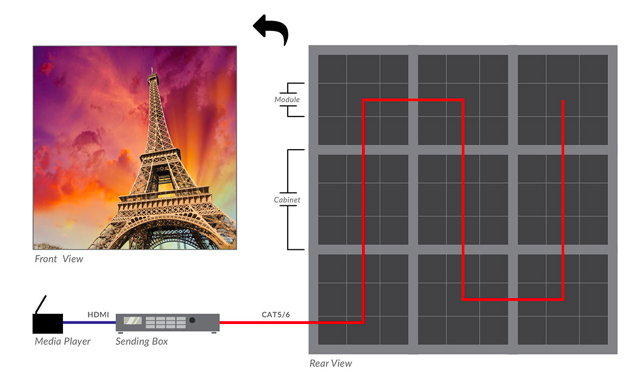LED Digital Signage 101
LED Digital Signage 101
Everyone has most likely seen an LED Video Wall. They are one of the most visible forms of Digital Signage with huge billboards in Times Square and Piccadilly Circus now iconic locations. The technology is more obtainable than ever with a variety of indoor and outdoor solutions. In this blog I am going to talk about the basic anyone should know about LED Video Walls.
What is LED?
To put it simply LED’s are tiny light bulbs. The tiny light bulbs are arranged in a grid formation that make up an entire display. Think of each tiny lightbulb as one pixel on your computer screen. The lightbulbs are told by a sending box to change to a full range of colours to create an overall image on the display. Modular in nature, LED Video Walls are extremely versatile, able to fit any space indoors and outdoors; they are a premium Digital Signage solution.
How Does an LED Video Wall Work?
While LED Video Walls comprise of several components; the work flow is simple. You start at the media player; this sends the content to the sending box via HDMI. The sending box processes the content and tells the Video Wall how to display the content. The sending box sends the signal via CAT5 cable to the first LED cabinet with each subsequent cabinet daisy chained together so each cabinet knows what to display. That’s it! LED may seem more complicated then LCD screens but the theory is straightforward.
The media player used can be just like any traditional Digital Signage media player such as our Android Network Media Player. This means that your LED Video’s content can be updated by USB plug and play or remotely using our online CMS. Those familiar with our range of all-in-one products will understand how simple and easy it is to update your content using either of these methods.
What Does “Pixel Pitch” Mean?
Pixel Pitch is a very common term that you will hear a lot when talking about LED Video Walls. In layman terms pixel pitch refers to the distance between the LED lightbulbs. The distance between each LED changes the optimum viewing distance of the display. The lower the pixel pitch the closer the Video Wall can be viewed from. We often say that the pixel pitch number is a rough estimate in meters of the minimum viewing distance. So an LED Video Wall with a pixel pitch of 3.1 has an optimum viewing distance of around 3.1 meters.
How is an LED Video Wall Installed?
With smart interconnecting cabinets and secure magnets for the modules, installation can be relatively straightforward once several key factors are decided in advance. Where is the LED Video Wall being mounted; is it going on a wall or a custom built freestanding structure? Is the display a permanent install or a temporary rental? Once all these aspects are taken care of an LED Video Wall can be relatively easy and quick to install.
Do I Need to Maintain My LED Video Wall?
LED Video Walls are not always a ‘fit and forget’ type of technology and that is why we can offer maintenance packages where appropriate. LED is one of the most durable and reliable display technologies available but like any form of equipment it does need to be properly maintained to ensure optimum performance. The failure rate of LED is astonishingly low and even when it does occur the modules can be easily accessed and swapped out. The level of maintenance required can be mitigated by considering certain factors during the design and installation stage
Source : Tom Rock for Allsee Technology


